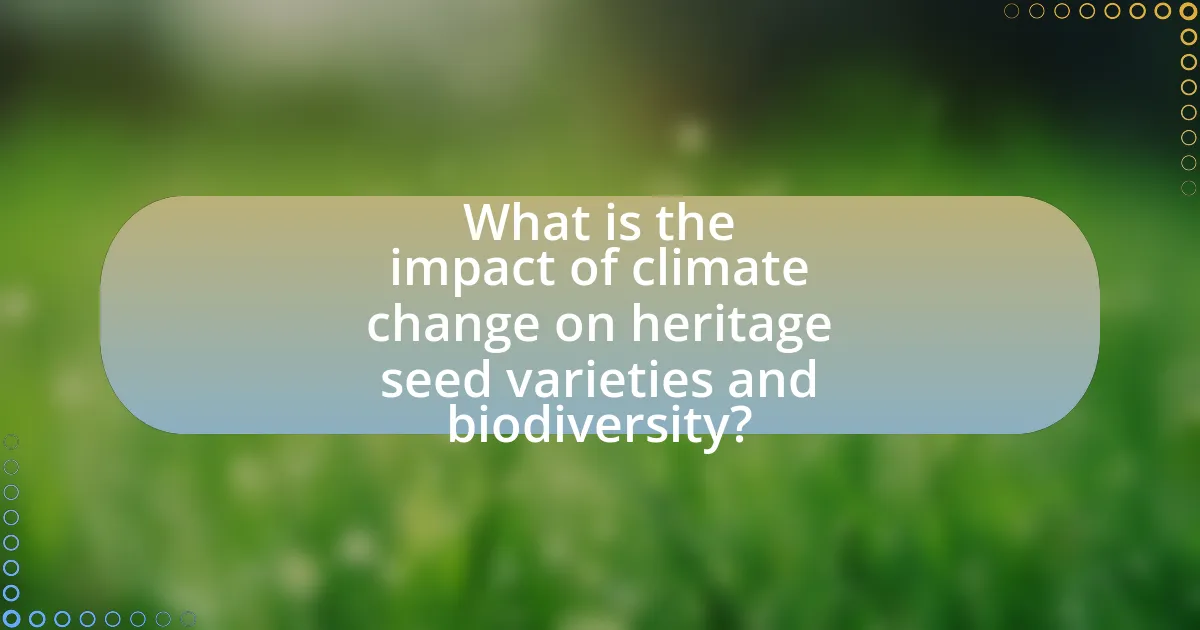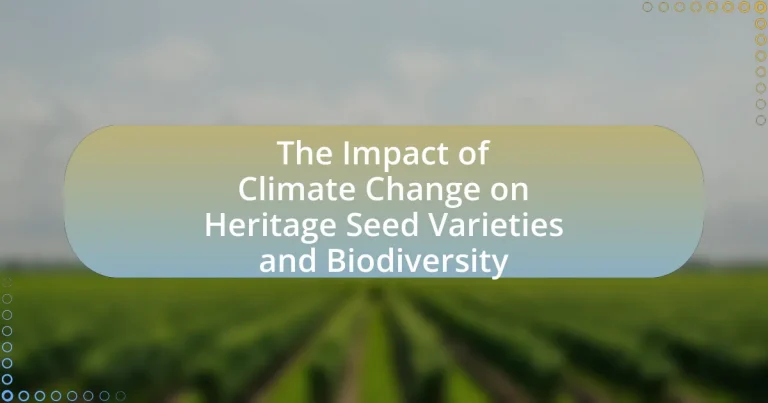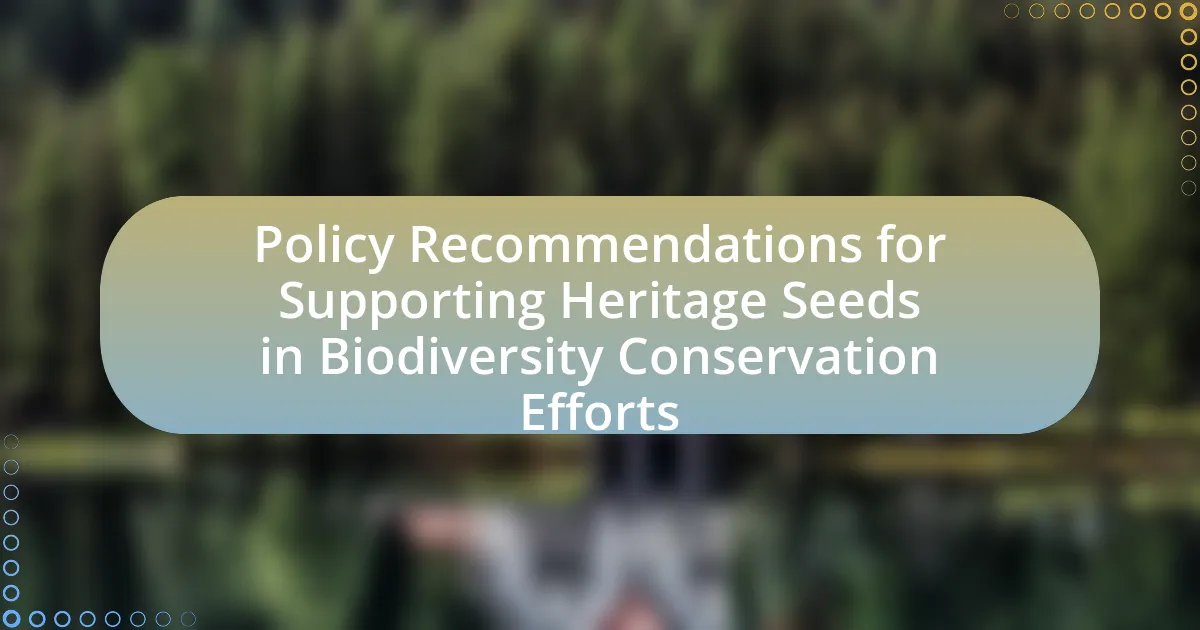The article examines the impact of climate change on heritage seed varieties and biodiversity, highlighting how altered growing conditions lead to reduced crop yields and increased vulnerability to pests and diseases. It discusses specific climate factors such as temperature and precipitation patterns that affect the growth and viability of these traditional seeds, which are crucial for maintaining genetic diversity in agriculture. The article emphasizes the importance of heritage seed varieties for ecosystem stability and food security, detailing the potential consequences of their loss, including diminished agricultural biodiversity and increased food insecurity. Strategies for mitigating these impacts, such as seed banking, community seed saving initiatives, and sustainable agricultural practices, are also explored to support the preservation of heritage seeds and biodiversity in the face of climate change.

What is the impact of climate change on heritage seed varieties and biodiversity?
Climate change negatively impacts heritage seed varieties and biodiversity by altering growing conditions, leading to reduced crop yields and increased vulnerability to pests and diseases. As temperatures rise and precipitation patterns shift, many traditional seed varieties, which are often adapted to specific local climates, struggle to survive. Research indicates that climate change could lead to a loss of up to 50% of crop diversity by 2100, threatening food security and ecosystem resilience. Additionally, the decline in biodiversity reduces the genetic pool necessary for breeding new varieties that can withstand changing environmental conditions, further exacerbating the challenges faced by agriculture.
How does climate change affect the growth of heritage seed varieties?
Climate change negatively affects the growth of heritage seed varieties by altering temperature and precipitation patterns, which can disrupt their traditional growing conditions. For instance, increased temperatures can lead to heat stress, reducing germination rates and crop yields. Additionally, changes in rainfall can result in drought or flooding, both of which can adversely impact soil health and seed viability. Research indicates that heritage varieties, which often have specific adaptations to local climates, may struggle to cope with these rapid environmental changes, leading to a decline in their cultivation and biodiversity.
What specific climate factors influence heritage seed varieties?
Specific climate factors that influence heritage seed varieties include temperature, precipitation patterns, humidity, and soil moisture levels. These factors directly affect the growth, yield, and adaptability of heritage seeds. For instance, temperature fluctuations can lead to altered flowering times and reduced pollination success, while changes in precipitation can impact soil moisture availability, crucial for seed germination and plant health. Research indicates that heritage varieties often possess unique traits that allow them to thrive in specific climatic conditions, making them more susceptible to shifts in climate. Studies have shown that as average temperatures rise, certain heritage varieties may struggle to survive outside their traditional growing regions, leading to a loss of biodiversity.
How do changes in temperature and precipitation impact seed viability?
Changes in temperature and precipitation significantly affect seed viability by altering germination rates and seed longevity. Higher temperatures can accelerate seed aging and reduce the time seeds remain viable, while increased precipitation can lead to waterlogging or fungal infections, both of which negatively impact seed health. Research indicates that seeds exposed to extreme temperature fluctuations exhibit reduced germination rates, with studies showing that a 1°C increase can decrease germination by up to 10% for some species. Additionally, inconsistent precipitation patterns can disrupt the moisture balance necessary for seed germination, leading to lower survival rates in various plant species.
Why are heritage seed varieties important for biodiversity?
Heritage seed varieties are crucial for biodiversity because they preserve genetic diversity within plant species. This genetic diversity enhances ecosystem resilience, allowing plants to adapt to changing environmental conditions, such as those caused by climate change. For instance, heritage varieties often possess traits that enable them to withstand pests, diseases, and extreme weather, which modern hybrids may lack. According to a study published in the journal “Biodiversity and Conservation,” maintaining diverse seed varieties can significantly contribute to agricultural sustainability and food security, particularly in the face of climate challenges.
What role do heritage seed varieties play in ecosystem stability?
Heritage seed varieties play a crucial role in ecosystem stability by enhancing biodiversity and resilience against environmental changes. These traditional seeds are often well-adapted to local conditions, which allows them to thrive in diverse ecosystems and contribute to soil health, pest resistance, and crop diversity. Research indicates that maintaining a variety of seed types can mitigate the risks associated with climate change, as diverse genetic resources provide options for adaptation to shifting climatic conditions. For instance, a study published in the journal “Agricultural Systems” highlights that heritage varieties can improve ecosystem services, such as pollination and nutrient cycling, thereby supporting overall ecosystem functionality and stability.
How do heritage seeds contribute to genetic diversity in agriculture?
Heritage seeds contribute to genetic diversity in agriculture by preserving a wide range of genetic traits that are not found in modern commercial varieties. These seeds, often heirloom varieties, have been cultivated over generations, resulting in unique adaptations to local climates and soils. For example, a study by the Seed Savers Exchange highlights that heritage seeds can exhibit resistance to pests and diseases, which is crucial for sustainable farming practices. By maintaining diverse genetic resources, heritage seeds enhance resilience against environmental changes, ensuring food security and agricultural sustainability in the face of climate change.
What are the potential consequences of losing heritage seed varieties?
Losing heritage seed varieties can lead to significant consequences, including reduced agricultural biodiversity and increased vulnerability to pests and diseases. Heritage seeds often possess unique traits that allow them to thrive in specific environmental conditions, contributing to ecosystem resilience. The loss of these varieties diminishes genetic diversity, which is crucial for adapting to climate change and ensuring food security. For instance, a study by the Food and Agriculture Organization indicates that the erosion of genetic diversity in crops can lead to a 10-20% decrease in yield potential under changing climate conditions. Additionally, the disappearance of heritage seeds can result in the loss of cultural heritage and traditional farming practices, as these seeds are often integral to local identities and cuisines.
How does the loss of these varieties affect food security?
The loss of heritage seed varieties significantly undermines food security by reducing genetic diversity essential for resilient agricultural systems. This diminished diversity limits the ability of crops to adapt to changing climate conditions, pests, and diseases, which can lead to decreased yields and increased vulnerability of food supplies. For instance, a study by the Food and Agriculture Organization (FAO) indicates that genetic diversity in crops is crucial for maintaining food production under stress conditions, as diverse varieties can offer different traits that enhance survival and productivity. Therefore, the erosion of these varieties directly threatens the stability and availability of food resources globally.
What implications does this loss have for future agricultural practices?
The loss of heritage seed varieties due to climate change has significant implications for future agricultural practices. This loss reduces genetic diversity, which is crucial for developing crops that can withstand changing climate conditions, pests, and diseases. For instance, a study by the Food and Agriculture Organization indicates that genetic diversity in crops is essential for food security, as it allows for the adaptation of agriculture to environmental changes. Without a diverse gene pool, farmers may face increased vulnerability to crop failures, leading to reduced yields and higher food prices. Additionally, the reliance on a limited number of commercial seed varieties can exacerbate the risks associated with monoculture farming, further threatening agricultural sustainability.

How can we mitigate the impact of climate change on heritage seed varieties?
To mitigate the impact of climate change on heritage seed varieties, implementing conservation strategies such as seed banking, in situ conservation, and promoting agroecological practices is essential. Seed banking preserves genetic diversity by storing seeds in controlled environments, ensuring they remain viable for future planting. In situ conservation involves maintaining heritage varieties in their natural habitats, allowing them to adapt to changing climate conditions. Additionally, agroecological practices, which emphasize biodiversity, soil health, and sustainable farming techniques, can enhance the resilience of these seed varieties against climate stressors. Research indicates that maintaining genetic diversity through these methods can improve crop resilience, as demonstrated by studies showing that diverse plant populations are better able to withstand environmental changes.
What strategies can be employed to preserve heritage seed varieties?
Strategies to preserve heritage seed varieties include establishing seed banks, promoting community seed saving initiatives, and implementing sustainable agricultural practices. Seed banks, such as the Svalbard Global Seed Vault, store genetic material to safeguard against loss due to climate change or disasters. Community seed saving initiatives encourage local farmers to maintain and exchange heritage seeds, fostering biodiversity and resilience. Sustainable agricultural practices, including organic farming and crop rotation, help maintain soil health and support the cultivation of diverse seed varieties, ensuring their continued availability and adaptation to changing climates.
How can seed banks contribute to the conservation of heritage seeds?
Seed banks contribute to the conservation of heritage seeds by preserving genetic diversity and providing a repository for rare and endangered seed varieties. These facilities store seeds in controlled environments, ensuring their viability for long periods, which is crucial for maintaining the genetic traits of heritage seeds that may be lost due to climate change or agricultural practices. For instance, the Svalbard Global Seed Vault, established in 2008, safeguards over a million seed samples from around the world, including many heritage varieties, thereby acting as a global insurance policy against biodiversity loss. This preservation allows for future research, breeding programs, and restoration efforts, ensuring that heritage seeds remain available for future generations.
What role do community seed saving initiatives play in preservation?
Community seed saving initiatives play a crucial role in the preservation of biodiversity and heritage seed varieties by maintaining genetic diversity and promoting sustainable agricultural practices. These initiatives enable local communities to collect, store, and share seeds that are well-adapted to their specific environments, thus ensuring the survival of traditional crops that may be threatened by climate change. For instance, a study by the Food and Agriculture Organization (FAO) highlights that community seed banks can safeguard over 1,000 varieties of local crops, which are essential for food security and resilience against climate fluctuations. By fostering a culture of seed sharing and education, these initiatives empower communities to protect their agricultural heritage and adapt to changing climatic conditions effectively.
How can farmers adapt to changing climate conditions?
Farmers can adapt to changing climate conditions by implementing sustainable agricultural practices, such as crop diversification, soil management, and water conservation techniques. Crop diversification allows farmers to select varieties that are more resilient to climate stressors, thereby reducing the risk of crop failure. For instance, research indicates that integrating drought-resistant heritage seed varieties can enhance yield stability in arid regions. Soil management practices, including cover cropping and reduced tillage, improve soil health and increase its capacity to retain moisture, which is crucial during periods of drought. Additionally, adopting water conservation techniques, such as drip irrigation, can optimize water use efficiency, ensuring crops receive adequate hydration even in changing precipitation patterns. These strategies collectively enhance resilience against climate variability, supporting both agricultural productivity and biodiversity conservation.
What practices can enhance resilience in heritage seed cultivation?
Practices that can enhance resilience in heritage seed cultivation include crop rotation, intercropping, and the use of organic amendments. Crop rotation helps to break pest and disease cycles, improving soil health and reducing reliance on chemical inputs. Intercropping, which involves growing different crops in proximity, can enhance biodiversity and reduce the risk of total crop failure due to pests or adverse weather conditions. The application of organic amendments, such as compost or green manure, improves soil structure and fertility, making plants more resilient to climate variability. Research indicates that these practices not only support sustainable agriculture but also contribute to the preservation of genetic diversity in heritage seed varieties, which is crucial for adapting to changing climate conditions.
How can agroecological approaches support biodiversity?
Agroecological approaches support biodiversity by promoting diverse cropping systems and enhancing ecosystem services. These methods, such as intercropping and agroforestry, create habitats for various species, which increases genetic diversity and resilience against pests and diseases. Research indicates that farms employing agroecological practices can host up to 50% more species compared to conventional farms, thereby contributing to overall biodiversity conservation. Additionally, agroecological practices improve soil health and water retention, further supporting diverse biological communities.

What are the broader implications of climate change on biodiversity?
Climate change significantly threatens biodiversity by altering habitats, disrupting ecosystems, and increasing extinction rates. As temperatures rise and weather patterns shift, many species struggle to adapt to new conditions, leading to habitat loss and fragmentation. For instance, a study published in “Nature” indicates that climate change could drive one in six species to extinction if global temperatures rise by 2 degrees Celsius. Additionally, changing precipitation patterns affect water availability, further stressing plant and animal populations. These changes can lead to a decline in genetic diversity, particularly among heritage seed varieties, which are crucial for maintaining resilient ecosystems.
How does climate change threaten global biodiversity?
Climate change threatens global biodiversity primarily by altering habitats and disrupting ecosystems. Rising temperatures, changing precipitation patterns, and increased frequency of extreme weather events lead to habitat loss, which directly impacts species survival. For instance, a study published in “Nature” by Thomas et al. (2004) indicates that climate change could drive 15-37% of species to extinction if global temperatures rise by 2°C. Additionally, shifting climatic conditions can result in mismatches between species and their environments, affecting food availability and breeding patterns. This disruption can lead to decreased genetic diversity, making ecosystems more vulnerable to diseases and further environmental changes.
What species are most at risk due to climate change?
Coral reefs, polar bears, and certain amphibians are among the species most at risk due to climate change. Coral reefs are threatened by rising ocean temperatures and acidification, which lead to bleaching and habitat loss. Polar bears face diminishing sea ice, crucial for their hunting and breeding. Amphibians, such as the golden toad, are vulnerable to changing climates and habitat destruction, leading to population declines. These species exemplify the broader impact of climate change on biodiversity, as evidenced by studies indicating that climate change could lead to the extinction of up to one million species globally.
How does habitat loss contribute to declining biodiversity?
Habitat loss significantly contributes to declining biodiversity by reducing the available living space for various species, leading to population declines and extinctions. When natural habitats are destroyed or fragmented due to human activities such as agriculture, urban development, and deforestation, species lose their homes and resources necessary for survival. According to the World Wildlife Fund, habitat loss is one of the primary drivers of species extinction, with approximately 1 million species at risk of extinction due to habitat destruction. This loss disrupts ecosystems, diminishes genetic diversity, and impairs the ability of species to adapt to environmental changes, further exacerbating the decline in biodiversity.
What actions can be taken to protect biodiversity in the face of climate change?
To protect biodiversity in the face of climate change, implementing conservation strategies such as establishing protected areas, restoring ecosystems, and promoting sustainable land-use practices is essential. Protected areas help safeguard habitats from development and degradation, while ecosystem restoration can revive damaged environments, enhancing resilience against climate impacts. Sustainable land-use practices, including agroecology and organic farming, support biodiversity by maintaining healthy ecosystems and reducing chemical inputs. According to the Intergovernmental Science-Policy Platform on Biodiversity and Ecosystem Services, effective conservation measures can significantly mitigate biodiversity loss, emphasizing the importance of these actions in the context of climate change.
How can policy changes support biodiversity conservation?
Policy changes can support biodiversity conservation by implementing regulations that protect natural habitats and promote sustainable land use practices. For instance, the establishment of protected areas through legislation can safeguard critical ecosystems from development and degradation, thereby preserving the species that inhabit them. Additionally, policies that incentivize sustainable agricultural practices, such as organic farming and agroecology, can enhance biodiversity by reducing chemical inputs and promoting crop diversity. Evidence from the Convention on Biological Diversity indicates that countries with strong environmental policies have seen improvements in biodiversity metrics, demonstrating the effectiveness of such policy changes in conservation efforts.
What role do individuals play in promoting biodiversity protection?
Individuals play a crucial role in promoting biodiversity protection by engaging in sustainable practices and advocating for conservation efforts. Their actions, such as reducing waste, supporting local and organic farming, and participating in community conservation projects, directly contribute to the preservation of diverse ecosystems. For instance, studies show that community-led initiatives can enhance local biodiversity by restoring habitats and protecting endangered species. Additionally, individuals can influence policy by raising awareness and supporting legislation aimed at environmental protection, thereby amplifying their impact on biodiversity conservation.
What practical steps can be taken to support heritage seed varieties and biodiversity?
To support heritage seed varieties and biodiversity, individuals and organizations can implement several practical steps. First, they can establish community seed banks to conserve and distribute heritage seeds, ensuring genetic diversity is maintained. Research indicates that seed banks play a crucial role in preserving plant genetic resources, with the Svalbard Global Seed Vault housing over a million seed samples from around the world. Additionally, promoting organic farming practices helps protect heritage varieties from the pressures of industrial agriculture, which often favors monocultures. Studies show that organic farms support higher levels of biodiversity compared to conventional farms. Furthermore, educating farmers and consumers about the importance of heritage seeds can foster a market demand for these varieties, encouraging their cultivation. Engaging in local seed exchanges can also facilitate the sharing of heritage seeds among growers, enhancing community resilience and biodiversity.





